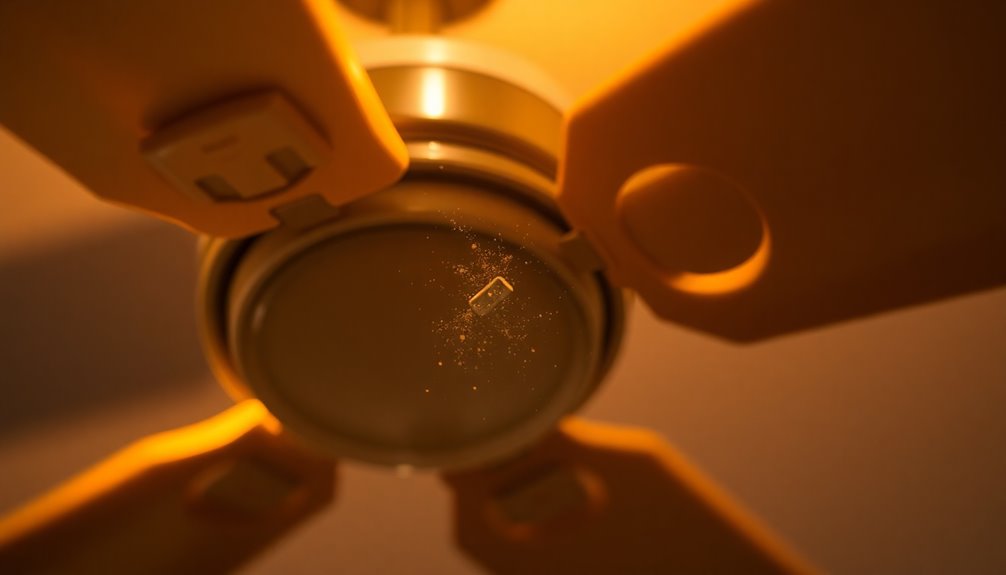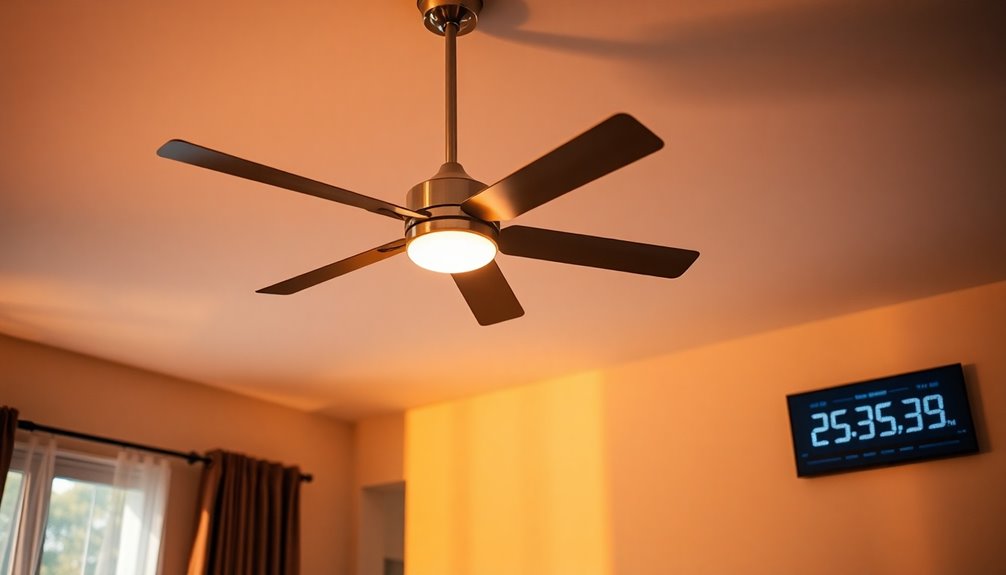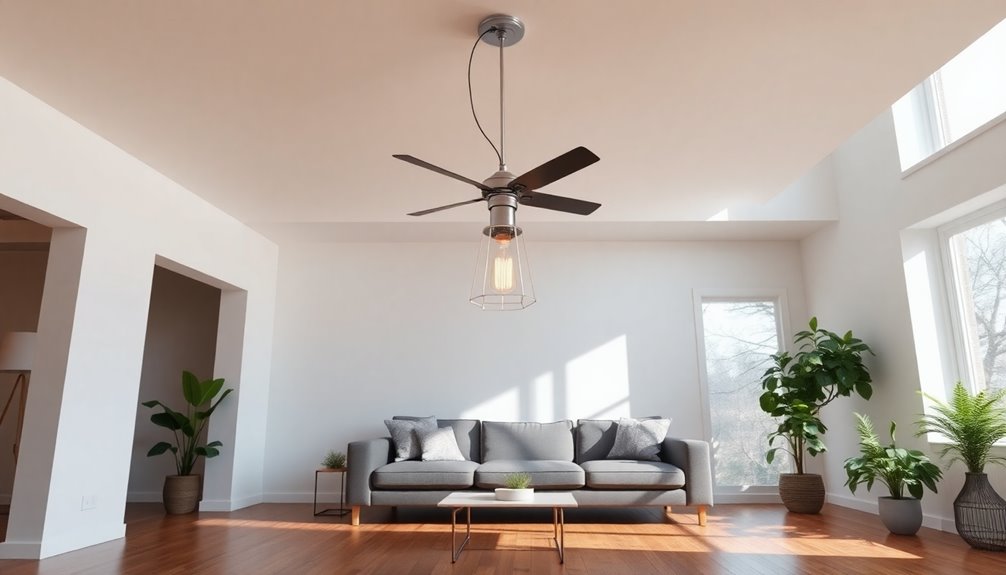Ceiling fans click for a few common reasons, usually related to loose parts or alignment issues. You might have loose screws on the blade arms or a canopy that isn't flush with the ceiling. Loose hanging brackets or unstable electrical boxes can also cause persistent clicking sounds. If the fan blades weren't installed correctly, they might rub against other components, creating noise. Regular maintenance and tightening connections often help resolve these issues. If clicking continues despite your efforts, there's more to uncover about potential underlying problems that could need professional attention.
Key Takeaways
- Loose screws on blade arms often create sporadic clicking noises in ceiling fans.
- Misaligned blades or obstructions can also lead to intermittent clicking sounds.
- A canopy that isn't flush with the ceiling may cause movement and noise.
- Electrical issues, such as exposed wiring, can result in persistent clicking or ticking.
- Regular maintenance is essential to prevent clicking, including tightening screws and lubricating parts.
Common Causes of Clicking Noises

When you hear clicking noises coming from your ceiling fan, it can be frustrating and distracting. One common culprit is loose screws on the blade arms. These screws can cause sporadic clicking noises that might annoy you even more than a dripping faucet.
Another possibility is a canopy that isn't flush with the ceiling. If it moves against the ceiling or housing, you might hear clicking sounds, which means you'll need a noise inspection and possibly some tightening of screws.
Additionally, loose hanging brackets or unstable electrical outlet boxes can lead to persistent clicking sounds. You can test for stability by gently pushing the fan side to side.
In flush mount fans, exposed wiring may hit the motor, creating a ticking noise. Proper inspection and tucking of those wires can eliminate this issue.
Finally, if you hear scraping or grinding noises, it could indicate bad bearings or loose blade irons scraping the motor. This suggests a need for immediate attention, as it might require fan replacement.
Addressing these common causes will help restore peace and quiet to your space.
Troubleshooting Clicking Sounds

Often, clicking sounds from your ceiling fan can be frustrating, but troubleshooting them is usually straightforward. Start by checking for loose screws on the fan blades. Tightening any loose screws can often eliminate the noise.
Next, inspect the blade holders for signs of looseness; secure attachments are essential to prevent clicking sounds during operation. Confirm the fan blades are properly aligned and free from obstructions. Misalignment or foreign objects can cause recurrent clicking noises.
Regular maintenance is key here; don't forget to check for loose connections in the light fixture or canopy as these can also contribute to the noise.
If you've tightened screws and checked for obstructions but the clicking persists, it might be time to contemplate a professional evaluation. A technician can assess any underlying issues that may not be immediately visible.
They can help confirm everything is in proper alignment and functioning correctly. Addressing these potential problems early can save you from more significant issues down the line, allowing you to enjoy your ceiling fan without the annoyance of clicking sounds.
Preventive Maintenance Tips

To keep your ceiling fan running smoothly and quietly, regular preventive maintenance is vital. Start by inspecting all the screws on the fan blades and blade holders. Loose screws can lead to annoying clicking noises, so make certain you're tightening the screws as needed.
Additionally, don't forget to clean your ceiling fan regularly. Dust and debris can accumulate on the fan blades and housing, causing imbalance and noise over time.
Check that the canopy is securely attached to the ceiling. A loose canopy can also create those unwanted clicking sounds during operation. Proper lubrication of the fan motor and bearings is important, too. Use appropriate fan oil to reduce friction and prevent grinding noises that may arise from a dry motor.
Conduct periodic checks on the fan's wiring and electrical connections as well. Identifying potential issues in advance can save you from future clicking or other noise problems.
When to Call an Electrician

If you're hearing persistent clicking noises from your ceiling fan despite tightening screws and checking for obstructions, it's time to call an electrician. This clicking could be a sign of deeper electrical issues that need professional attention.
If you notice that the fan is making noise even when it's off, it could indicate wiring problems, which can pose serious hazards if left unchecked.
You should also consult an electrician if you've tried basic troubleshooting—like checking the canopy and aligning the blades—without success. Loose fan blades can sometimes cause clicking, but if the noise persists, it may signal a more significant issue.
Moreover, if the clicking is accompanied by crackling or sizzling sounds, don't hesitate to seek immediate assistance. This combination could indicate electrical damage or short circuits, which require urgent attention.
Finally, if your ceiling fan is old, say 15-20 years or more, and starts making unusual noises, it's wise to consult an electrician to assess its safety and functionality for possible replacement options. Staying proactive can help prevent accidents and guarantee your ceiling fan operates safely.
Choosing a Quiet Ceiling Fan

Selecting a quiet ceiling fan can greatly enhance your comfort at home. When you're choosing a quiet ceiling fan, opt for timber or plastic blades instead of metal. These materials typically produce less fan noise and improve balance.
Increasing the number of blades can also help; more blades allow for effective airflow at slower fan speeds, resulting in a quieter operation.
Look for rounded blade designs, as they reduce air disturbance and noise compared to square-cut blades, enhancing your overall experience. If you want the quietest option, consider a DC-powered fan. These models are considerably quieter and more energy efficient than traditional AC fans.
Don't forget about installation! Verify the downrod length is suitable for your ceiling height. An excessively long downrod can lead to a noisy ceiling fan due to imbalance.
During your search, keep an eye out for any loose blades and address these with simple troubleshooting to minimize that annoying click sound. With these tips in mind, you'll be well on your way to enjoying a peaceful atmosphere in your home.
Frequently Asked Questions
How Do I Stop My Ceiling Fan From Clicking?
To stop your ceiling fan from clicking, first, inspect and tighten all blade screws.
Check the blade holders for alignment and verify they're securely attached.
Next, make sure the fan canopy is tight against the ceiling, as any looseness can cause noise.
Also, examine the wiring around the motor; tuck any exposed wires to prevent contact.
Regularly clean dust from the blades and motor to maintain balance and prevent obstructions.
Why Does My Ceiling Make a Clicking Sound?
If your ceiling's making a clicking sound, it could be due to loose fixtures or possibly something in the attic shifting.
You might want to check for any loose nails or screws in the ceiling structure.
Sometimes, the sound comes from changes in temperature causing materials to expand or contract.
It's a good idea to inspect your ceiling thoroughly and address any potential issues to eliminate that annoying clicking noise.
Why Do Fans Make Clicking Noise?
You might think your ceiling fan is auditioning for a percussion solo with all that clicking noise!
But don't fret; it's usually just a few loose screws or a misaligned blade causing the ruckus.
Check the fan blades and the canopy for any loose connections, and make sure everything's snug.
Regular maintenance can save you from that endless clicking symphony, keeping your fan quiet and running smoothly for years to come!
Is It Normal for Ceiling Fans to Make Noise?
It's normal for ceiling fans to make some noise while operating, like a gentle hum.
However, if you're hearing persistent clicking or grinding sounds, that's a sign something might be off. Usually, loose components or improper installation cause these noises.
You should regularly check your fan for tight screws and obstructions to keep it running smoothly.
If you notice excessive noise, it might be time to investigate further.
Conclusion
Just like a well-tuned orchestra, your ceiling fan deserves harmony, not discord. If it clicks, it's signaling for a little attention. By troubleshooting the common causes and following preventive maintenance tips, you can guarantee your fan plays a soothing melody in your home. Remember, if the noise persists, don't hesitate to call in the professionals. Choose a fan that whispers, rather than one that clatters, and let your space breathe in peace.









